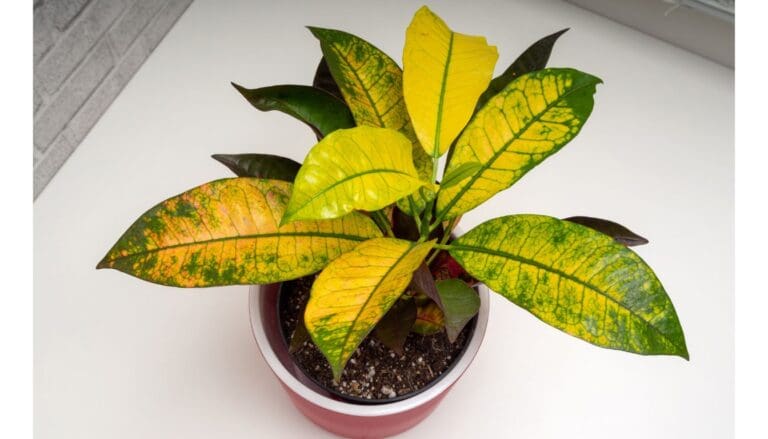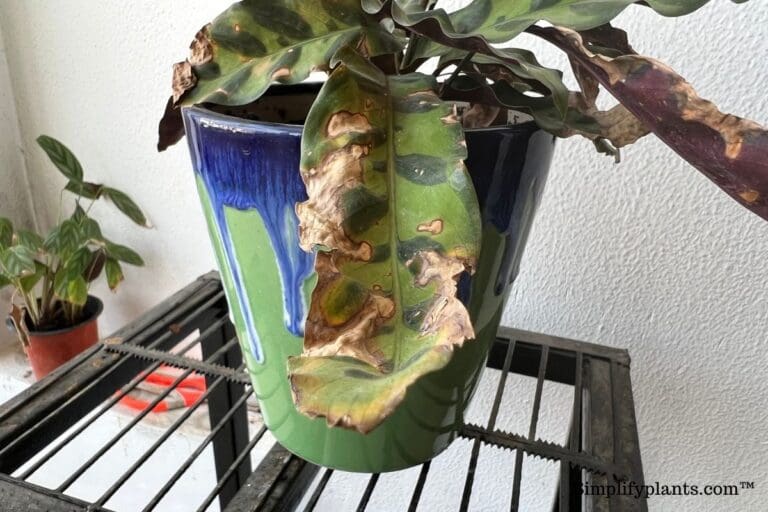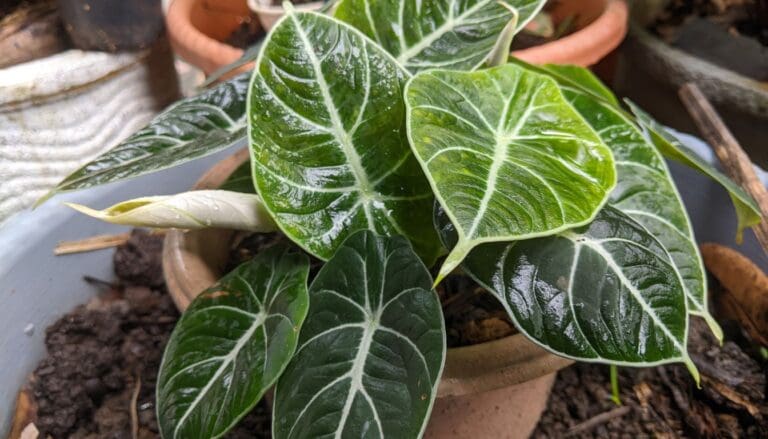How Fast Does Peace Lily Grow? (+9 Tips To Boost Growth)
Peace lilies are popular houseplants that get a lot of attention because of their dark green leaves, white flowers, and air purifying quality.
One common question that might strike you if you own a Peace Lily plant or want to buy one is how fast peace lilies grow and how big do they get. Let’s find out.
In general, peace lilies can grow anywhere between 1-6 inches every year, depending upon which species you pick. They will reach their maturity in 3-5 years. Peace lilies do well under indirect sunlight, with temperatures ranging from 65-85°F and average humidity above 50%.
However, the growth rate will reduce in the winter, which is the dormant period for these houseplants. You must not worry as it is a natural process of conserving energy.
This guide will make you understand all the factors that determine how fast your peace lily will grow.

Please note: Simplify Plants is reader-supported. Some links in the post are affiliate links and I get a commission from purchases made through links in the post.
How big do peace lilies get?
Among different factors that can affect the size of your peace lily plant, the plant species is a dominant one.
Most species you will come across grow 1-4 feet tall. However, while some species like Spathiphyllum Sensation can grow as tall as 6 feet, Spathiphyllum wallisii grows only around 1.25 feet tall.
Let’s check out some common species and their average sizes.
| Peace Lily Species | Average length |
| Spathiphyllum Sensation | 4-6 feet |
| Spathiphyllum Mauna Loa Supreme | 3-4 feet |
| Spathiphyllum clevelandii | 1-3 feet |
| Spathiphyllum wallisii | 1-1.25 feet |
Factors that affect the growth rate of peace lilies
We need to consider these factors for understanding the growth rate of the peace lily.
These factors affect the growth of all house plants, including your peace lily plant.
Let’s take a look.
- Season
- Light
- Water
- Fertilization
- Soil
- Temperature and humidity
- Pruning
- Pests
- Size of the pot
Now let’s dive into the details of all these factors one by one.
Season
The ideal time for the growth of the peace lily plant is during its growing seasons.
Most houseplants have their growing season from spring to summer, and the peace lily is no different. If you take proper care by providing the right amount of water and sufficient fertilizer, you will see a lot of growth during this period.
Your peace lily plant can grow up to 4-6 feet in height, although that depends on the species.
In the winter, however, the peace lilies move into the dormant period when you might not see any growth at all.
If this happens, don’t get stressed, as it is natural for the plants to become dormant in winter.
The low temperature and low light are not the ideal conditions for your peace lily. So it goes dormant and saves up energy for the coming growing season.
Hence, you should also avoid fertilizing during the winter.
Light
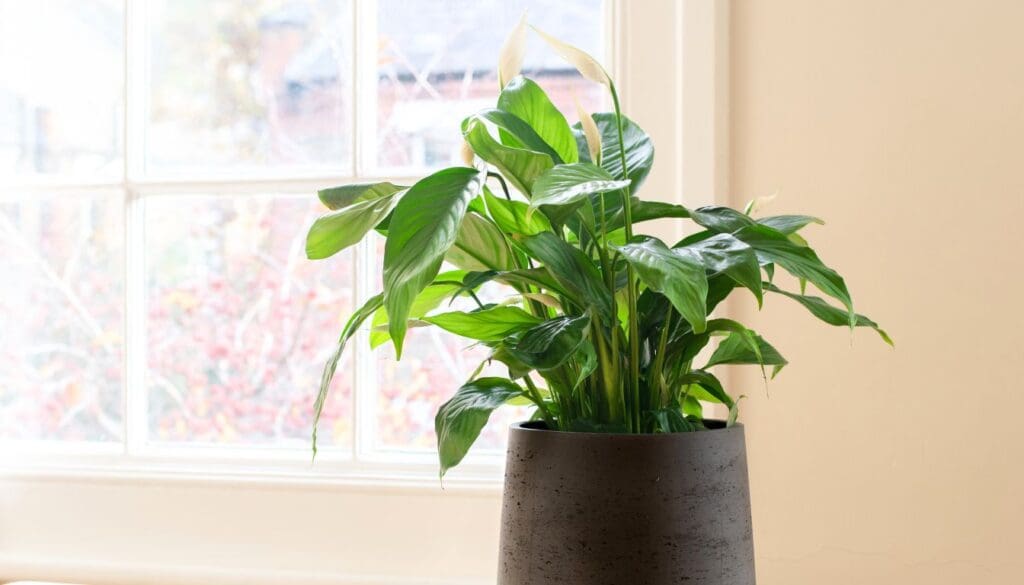
Light is a fundamental factor for a healthy and thriving peace lily plant. Peace lilies are famous for their low light tolerance.
However, low light becomes a problem when you don’t see much growth in your plant.
Light is the only source of food for the plants. Without enough light, the plants will not be able to produce enough energy for food. And you will see the result as slow growth.
Therefore, don’t get surprised to see that your peace lily is not growing as fast. The reason might be the placement where the plant is not getting enough light.
To improve the situation, try to find a bright spot inside your house where the Peace Lily will receive enough indirect light and relocate it.
Note: Don’t expose your peace lily to direct sunlight.
Also read: What Kind Of Light Does A Peace Lily Need? (Peace Lily Light Requirements)
Water

Watering your houseplants is tricky, and this is where most people make mistakes.
If you keep ignoring the water requirement of your peace lily, you will end up underwatering it, leading to slow growth. Without enough water, the plant will fail to function correctly.
On the other hand, too much care and excess watering will cause overwatering, leading to worse conditions such as root rot.
So, here are some ways to make sure that you are watering your peace lily correctly.
- Always use a well-draining potting mix.
- Touch the soil before you water the plant.
- The soil should not be wet. If it is, wait and let it dry before you water it.
- Insert your finger deep into the soil to determine the moistness.
- You can come up with a watering regime so that you don’t forget to water your peace lily.
- Clear the cache tray whenever it collects water.
- Don’t let your peace lily stand on still water.
On average, you can water your peace lily once a week in the growing season. And reduce the water supply in winter.
Excess water is not suitable for any houseplant, so you must ensure that you are not giving extra water to your peace lily plant.
Also read: How Often Should A Peace Lily Be Watered? (Peace Lily Water Requirements)
Fertilization
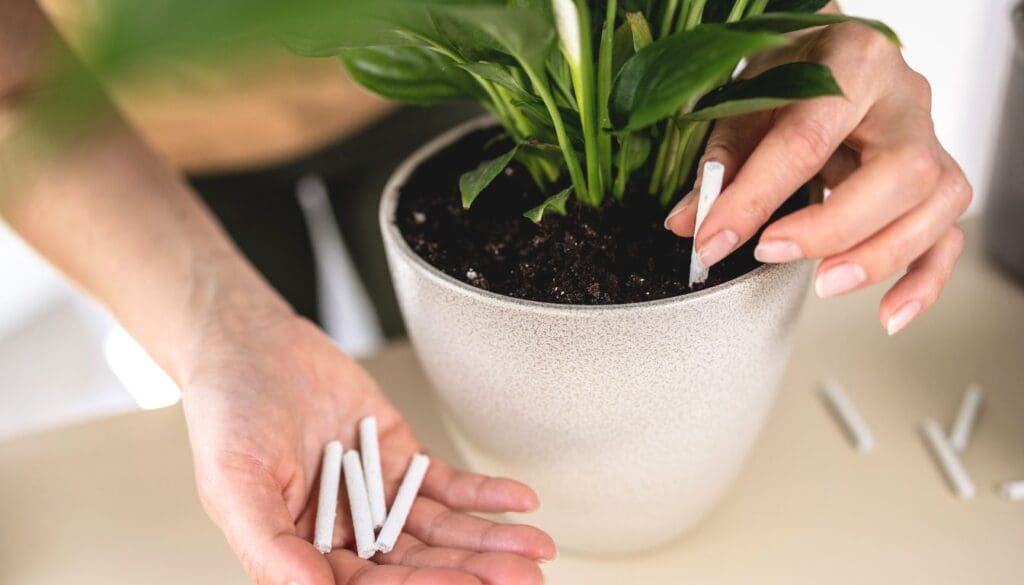
Fertilization is necessary for boosting the growth of your houseplants, so the growth rate of your Peace Lily plant will depend on whether you are fertilizing the plant correctly.
You can either give it too much fertilizer or too little. If you are giving too little fertilizer to your peace lily, the only problem you will face is slow growth.
You can tweak your fertilization routine and increase the supply if you have an underwatered peace lily.
But the primary concern is overfertilization. It can be highly stressful for the plant that is getting excess fertilizer. Overfertilization leads to salt build-up in the soil that can burn the roots, and you might see brown tips of the leaves of your peace lily plant.
You can fertilize your peace lily once a month during the growing season. Dilute the dose to reduce the strength of the fertilizer. This will ensure that your peace lily doesn’t get overfertilized.
You must reduce or stop the fertilization in the winter as that is the dormant period when the plant is not growing actively. So, fertilizing during this time will only lead to overfertilization.
Opt for a 20:20:20 fertilizer, and don’t forget to dilute the dose whenever you fertilize your peace lily the next time.
An overfertilized peace lily will cause drooping and falling of leaves. So, if you notice this sign, check the fertilization schedule and reduce it in case you are overdoing it.
Also read: What Kind Of Fertilizer Does A Peace Lily Need? (Peace Lily Fertilizer Ratio)
What to do with an overfertilized peace lily?
If you have an overfertilized peace lily plant, consider these:
- Place your peace lily under running water and wash the soil thoroughly to get rid of the excess salt.
- Continue this 3 to 4 times.
- You can consider repotting in a fresh potting mix that will rejuvenate the plant.
- Avoid fertilizing for at least a month. Let your peace lily recover.
- Water appropriately to help the plant recover.
Soil
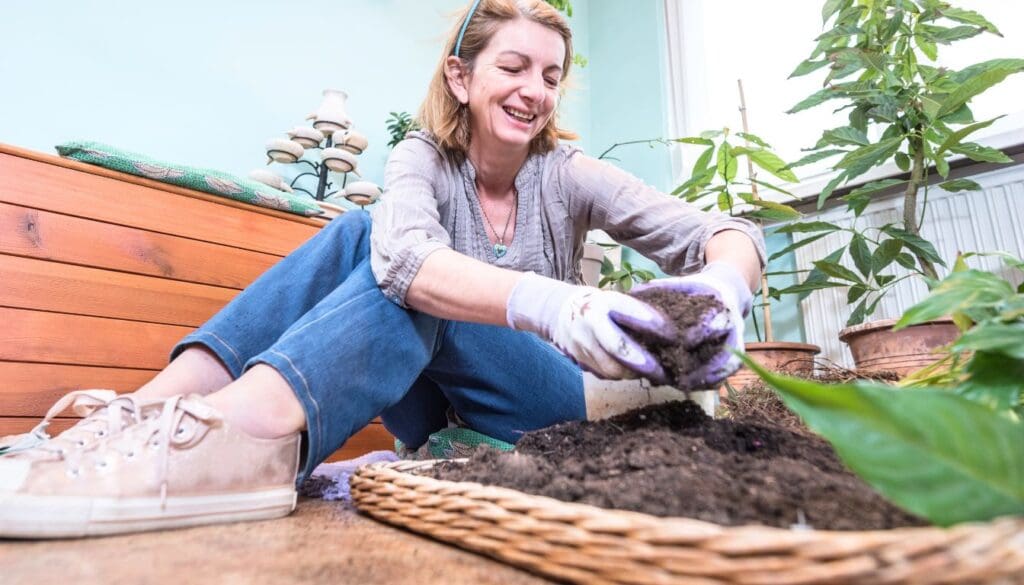
Soil is a crucial factor that determines the health and growth of plants. If the soil contains the essential nutrients, the plant will automatically absorb that from the soil and will show good growth.
Other than nutrient-rich soil, two more important factors are drainage and retention. Too little or too much will create an imbalance affecting the growth of your Peace Lily.
The best potting mix for your peace lily would be:
Loam will retain the required moisture. Peat moss will encourage aeration in the soil, and sand will improve the drainage.
Also read: What Kind Of Soil To Use For Peace Lily? (Peace Lily Soil Mix)
Temperature and humidity
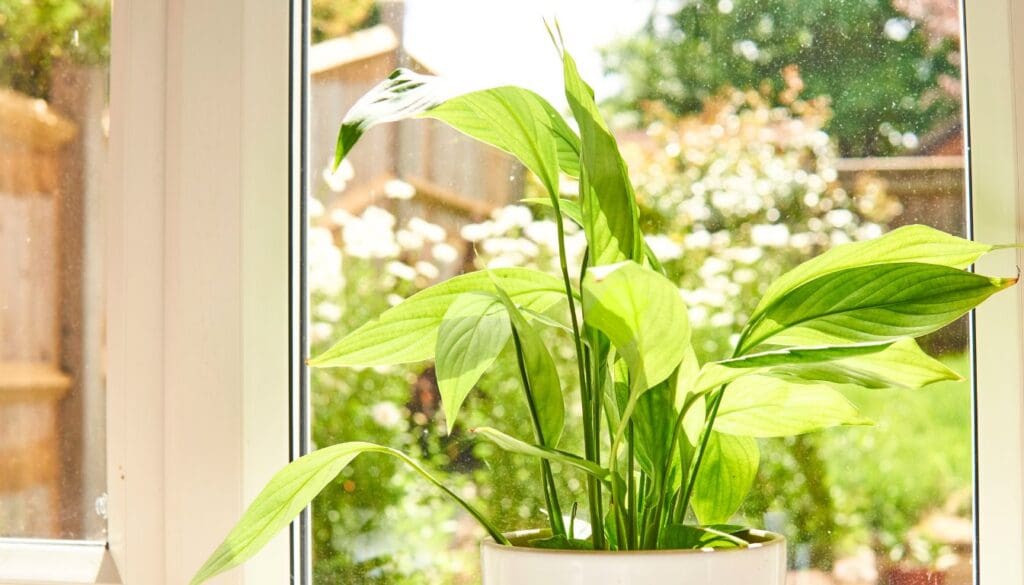
Peace lilies love a warm and humid climate. But mimicking the same conditions of the lands it originates from might not be possible.
Don’t worry. The average room temperature that keeps you comfortable will also keep your peace lily happy.
Try to find a place where it gets bright indirect light and average room temperature.
However, beware of cold drafts, heating vents, and the air coming from the AC. All these can have harmful effects on your peace lily plant.
When we talk about peace lily plants, you might need to take some steps to provide more humidity.
If your peace lily is going through humidity deficiency, it will show you signs like brown tips on leaves.
Consider giving your plant a good soak whenever you water it. Mist the foliage whenever possible to add some momentary moisture.
Consider opting for any of these:
- Get a humidifier
- Relocate the plant to the kitchen or bathroom
- Use a pebble tray
However, make sure that the drainage holes are not sitting in water when placing the plant on a pebble tray.
Pruning
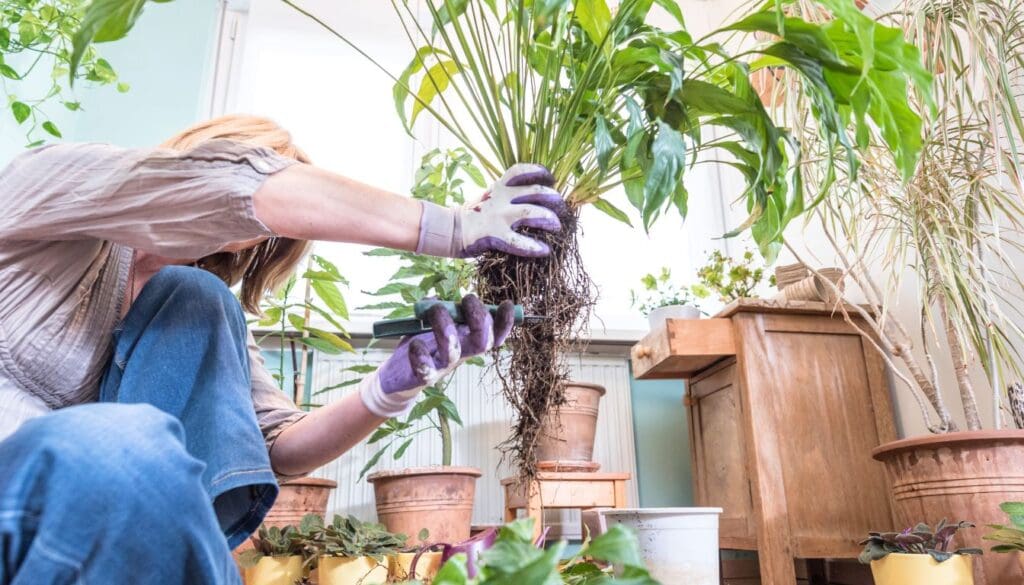
Pruning is essential for the growth of houseplants. Pruning can help your peace lily grow faster, and without pruning, you might not notice desired growth.
Pruning can help your pace lily:
- To get rid of the overgrowth
- To remove the damaged and diseased parts
- To boost the growth
Pruning will help you keep your peace lily in shape by eliminating excess growth that makes your plant look messy.
Many people don’t feel like pruning their plants, but you must remember that pruning can improve the growth rate of your peace lily, so don’t avoid this step.
Here are some tips for pruning your peace lily plant.
- Prune during the growing season as the plant will recover from the stress faster.
- Pruning during the dormant period can shock the plant.
- Always use sterilized pruners to avoid the spread of diseases or pests.
- Prune the damaged or dead parts of your peace lily.
- After pruning, place the plant in a bright spot with indirect light to help it recover.
Also Read: How To Prune A Peace Lily? (When+Steps-By-Step Guide)
Pests
One common pest that tends to attack the peace lily plant is mealybugs. These look like tiny cotton balls that are mostly found on the undersides of the leaves and the nodes.
Some other pests that can also feed on your peace lily plant are spider mites, scales, and aphids.
Overwatering and root rot are the ideal conditions for pests. Pests are more prone to attack unhealthy plants, so if you have a healthy peace lily, it is less likely to be attacked by pests.
If you notice that your peace lily has stopped growing or looks unhealthy, pests might be the reason.
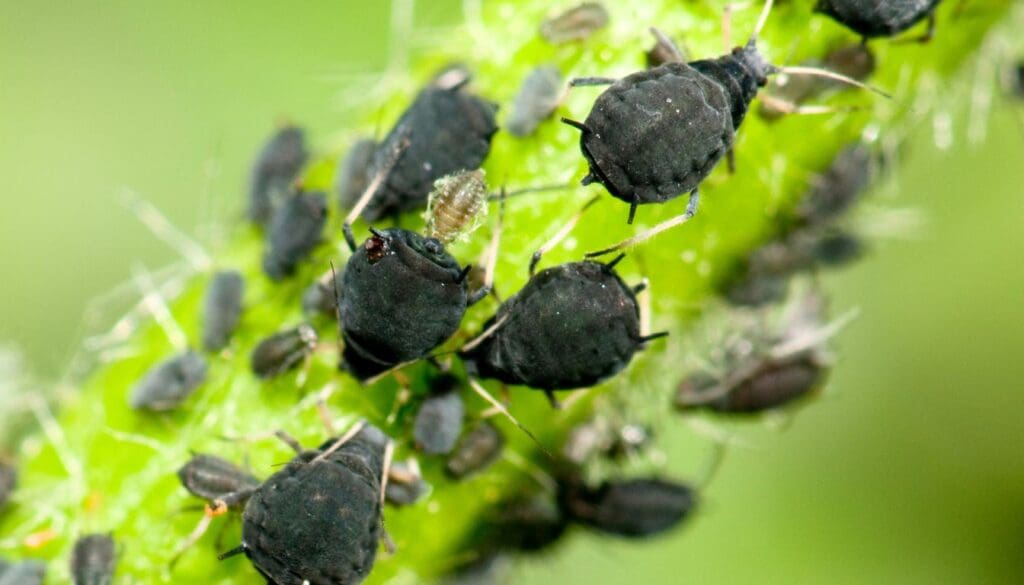
If you have a pest-infested peace lily plant, here’s what you should do:
- Isolate your peace lily from other plants so that pests will not attack them.
- Wash the plant under running water to wash off as many pests as possible.
- Create a neem oil solution and spray it on the peace lily.
- Do this for at least two weeks to kill the eggs of the pests.
- If this doesn’t work, get a pesticide that is available in the market or online.
- Do not add too much pesticide and use it after reading the label carefully.
Also Read: Do Peace Lily Attract Bugs? (Identification+How ToGet Rid Of Them)
Size of the pot
The size of the pot can define the growth of your peace lily. How? Let’s understand.
If your peace lily has outgrown its pot and is still living in a small pot, its roots will get root-bound due to lack of space.
If the roots don’t get enough space, they will not be able to function efficiently. There will be a shortage in the water and nutrient supply from the soil to the plant, and you will soon notice stunted growth.
To provide enough space to the roots, you must shift the peace lily to a new pot as soon as you find out that it is root-bound.
While choosing a pot, go for a pot that is one size bigger than the plant. For example, if your peace lily is 2 feet in height, it will require a 3-gallon pot.
As a thumb rule, you should repot your peace lily once in every 2-3 years to make sure it is not root-bound.
FAQ
How can I make my peace lilies grow faster?
Keep the following points in mind if you want to help your peace lily grow faster:
- Fertilize with a well-balanced fertilizer once a month or once every six weeks during the growing season.
- Prune the peace lily from time to time to eliminate the faulty growths and boost the plant’s growth hormone.
- Provide proper humidity as it is an essential factor that determines the growth. Mist the plant or install a humidifier or use a pebble tray.
- Maintain temperatures between 60-70°F.
How long does peace lily grow?
How long your peace lily grows will depend on which species you have and what conditions it is growing in.
You must provide sufficient indirect light if you want to see your peace lily growing long and healthy.
On average, a peace lily can grow anywhere between 1-6 feet tall.
Do peace lilies grow slow?
The peace lily is a moderate growing plant that grows neither slow nor too fast. But if you notice slow growth, it can be due to any of the factors mentioned above.
Your peace lily might not be getting enough light, enough fertilizers, too much water, or maybe it is root-bound.
If you have a slow-growing peace lily, check all the factors and if you are making a mistake anywhere, fix it and provide all the favorable conditions that the plant requires. You will see good growth in no time.
Ref: ScienceDirect, NCBI, University of Vermont, Nationalgeographic, NC state university, University of Florida, The University of Arkansas, Queensland Government.
Recommended Garden Supplies
| Product Image | Our Recommended Gardening Supplies | Check Offers! |
|---|---|---|
Top Top
Top
Top
Top
Top
Top
Top
Top | rePotme Houseplant and Tropical Classic Potting Soil Mix | Check Offer On Amazon |
 Top
Top
Top
Top
Top
Top
Top
Top | Espoma Organic Indoor Plant Food | Check Offer On Amazon |
 Top
Top
Top
Top
Top
Top
Top
Top | GooingTop LED Grow Light 6000K Full Spectrum Clip Plant Growing Lamp | Check Offer On Amazon |
 Top
Top
Top
Top
Top
Top
Top
Top | Soil Moisture Meter | Check Offer On Amazon |
 Top
Top
Top
Top
Top
Top
Top
Top | Govee Hygrometer Thermometer, Bluetooth Enabled! | Check Offer On Amazon |
 Top
Top | LEVOIT Humidifiers for Large Room(Best For Plants) | Check Offer On Amazon |
 Top
Top
Top
Top
Top
Top
Top
Top | Upgraded DIY Automatic Drip Irrigation Kit, 15 Potted Houseplants Support | Check Offer On Amazon |
 Top
Top
Top
Top
Top
Top
Top
Top | Stainless Steel Heavy Duty Gardening Tool Set | Check Offer On Amazon |
 Top
Top
Top
Top
Top
Top
Top
Top | Bonide Insecticidal Soap | Check Offer On Amazon |
 Top
Top
Top
Top
Top
Top
Top
Top | Bonide 32 oz Spray Neem Oil for Organic Gardening | Check Offer On Amazon |
 Top
Top
Top
Top
Top
Top
Top
Top | Garden Safe Fungicide | Check Offer On Amazon |


